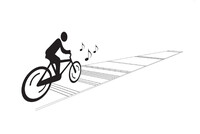
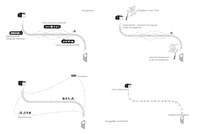
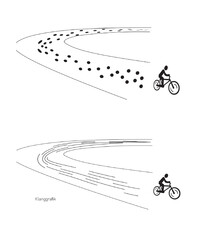
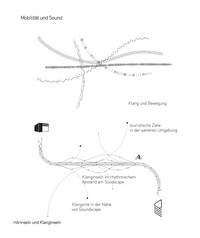
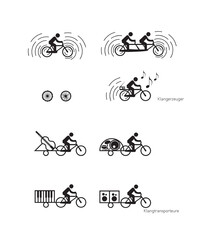
Soundscape - Design of a Route
A sounding discovery trail should create an eventful and attractive connection between the two musical institutions of the Rock’n’Pop Museum and the State Music Academy. Such a continuous path must use existing connections and, where these are insufficient, create new ones. This sound or listening path is staged through new and unfamiliar listening experiences, which are arranged along the route, but also at branching stations (sound or listening islands). The visual level not only refers to the course, but is itself an aesthetic element and sometimes even functions as a sound generator. This creates a linear soundscape, a soundscape, connecting the locations. The main means of transport is the bicycle, possibly supplemented by the inclusion of local transport.
Sondbikes as a sound generator. However, the bicycles are not just a classic means of transportation, they become sound objects themselves and the unmistakable ambassador of the soundscape. The bicycle is in itself a sound object, from the bell to the tires. For the project, however, own sound bicycles are to be developed, which, through appropriate tonal revision, become original sound instruments and encourage action and interaction with one another. E.g. when different people meet on the route, they communicate through their sound bikes and then via your sound bikes … A key sound is an unmistakable sound that creates a direct reference to the location, e.g. the ringing of the BigBen immediately associates “London”. The sound bikes can become such a sound brand for Heek-Gronau. Sound bikes are always musical instruments and not noise emitters.
Sound buses. Special sound buses connect the musical institutions at certain times on the weekend. Personalized sound zones are set up in regular buses. Certain seats are specially set up for sound projection and do not require headphones. So-called transducers can also be used to make the seats themselves vibrate so that the sound can be felt. The sound “travels” with the bus and the sounds change from station to station and can only be heard while the bus is in motion. It would also be conceivable to transfer the natural sounds of the environment through which the bus drives inside, the body of the means of transport would be acoustically more or less “transparent”.
Hearing islands and sound islands. As artistically designed zones, sound or listening islands offer an opportunity to linger on the route or as a branch. At sensible intervals they structure the course of the sound path and create independent attractions. The different aspects of the Heek-Gronau cultural landscape with the soundscapes of nature, cultural landscape, village and urban environment are included and made aware. Depending on the connection to the specific location, the islands focus on a topic of the defined structure: sound - perceive, understand, generate. You should be able to linger at the stations and find a different time rhythm. The perception is intensified and enriched. The listening islands offer an experience that can also be exchanged afterwards; They talk about it.